
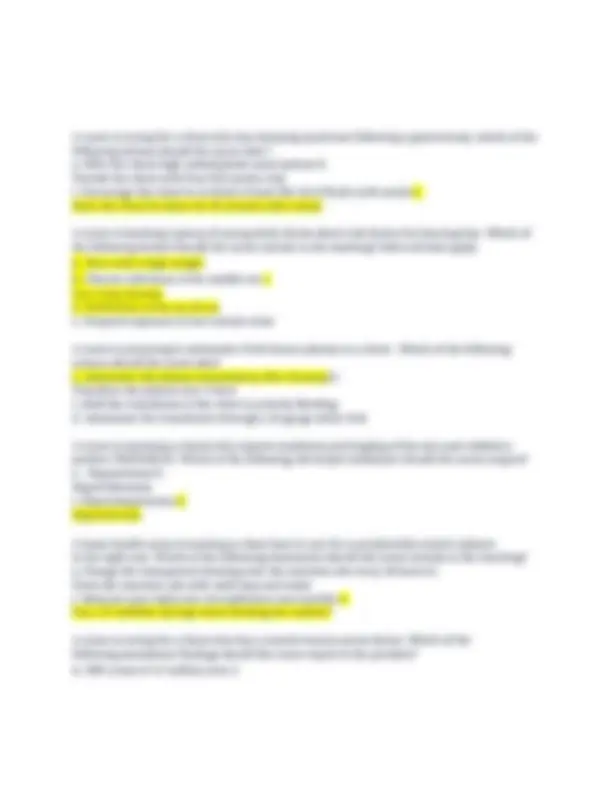
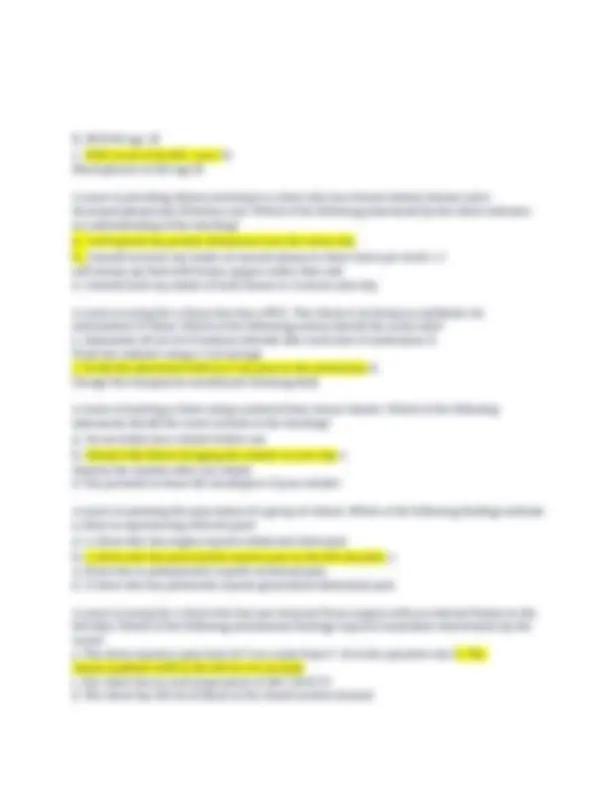
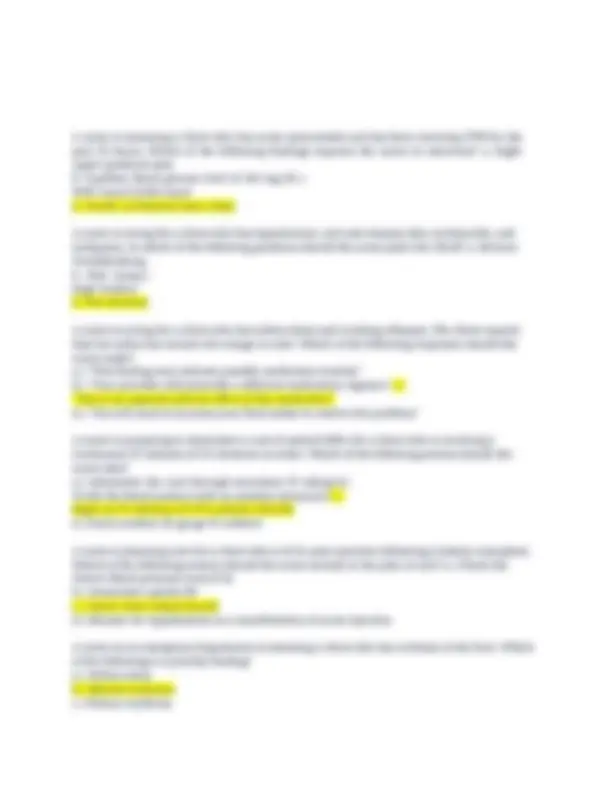
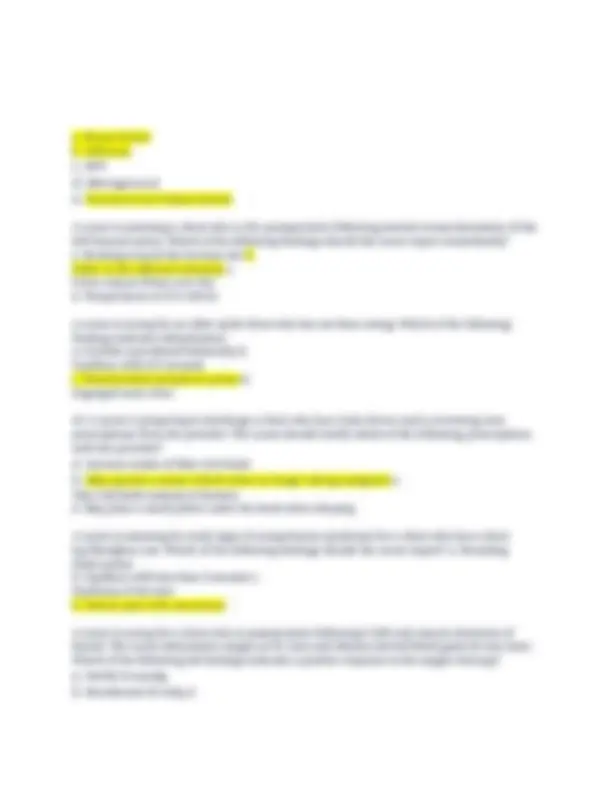
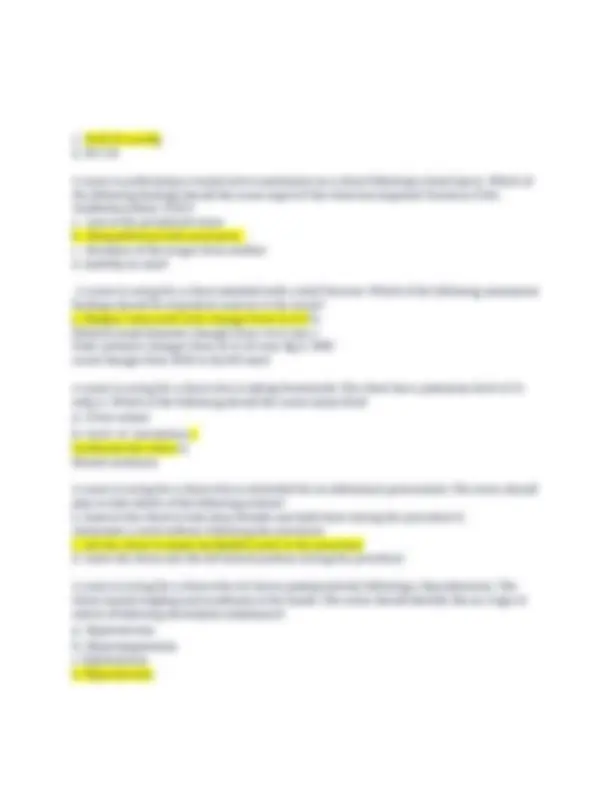
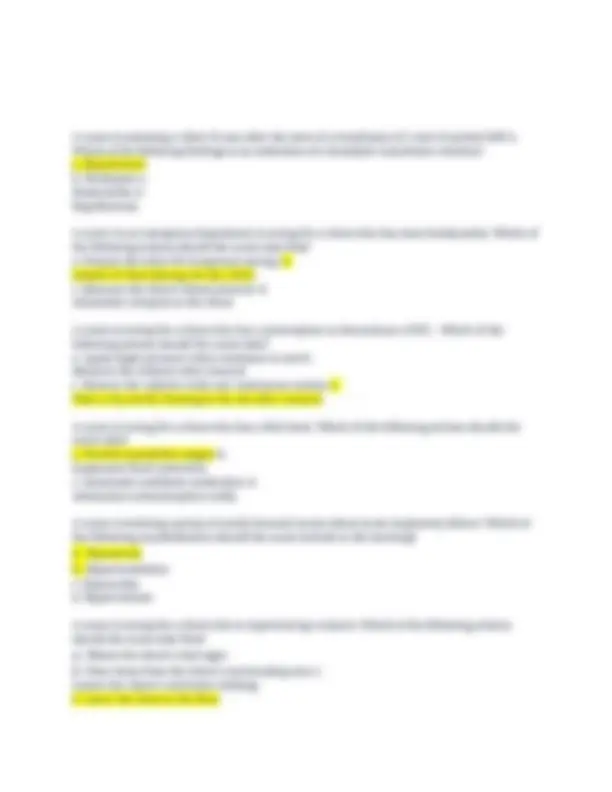
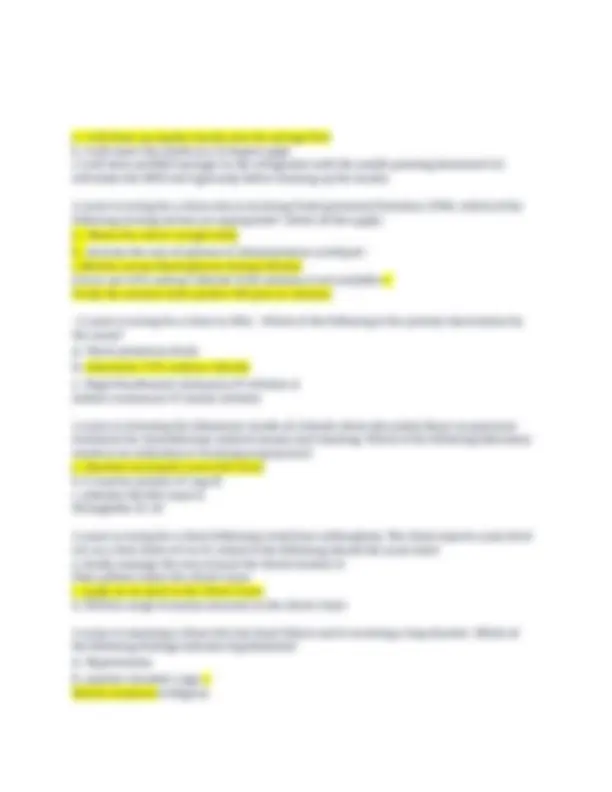
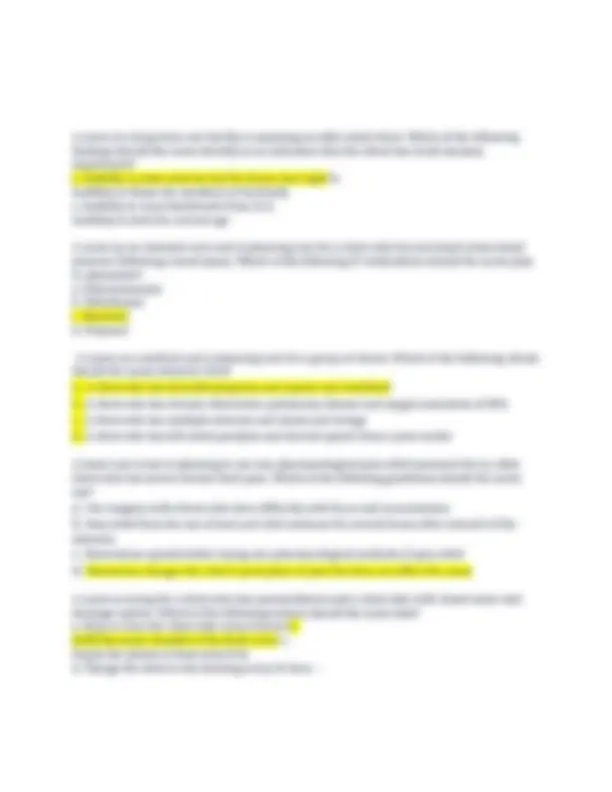
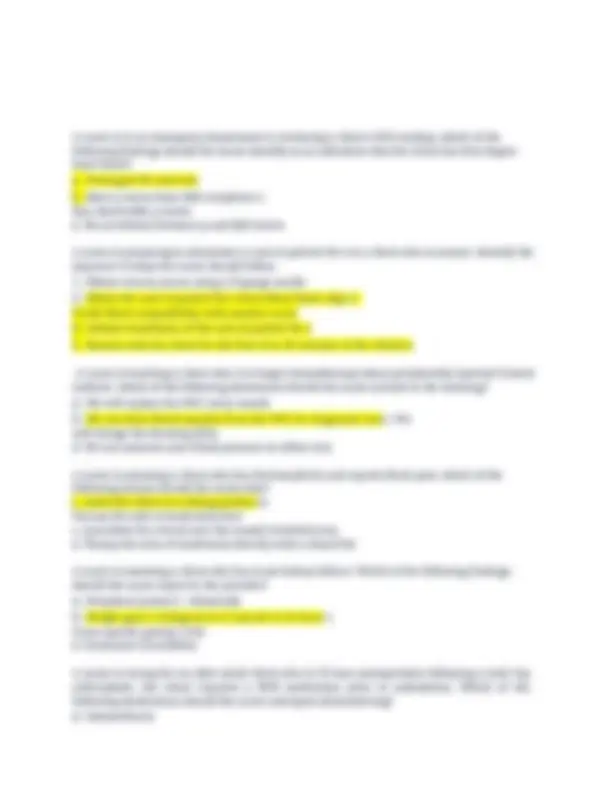
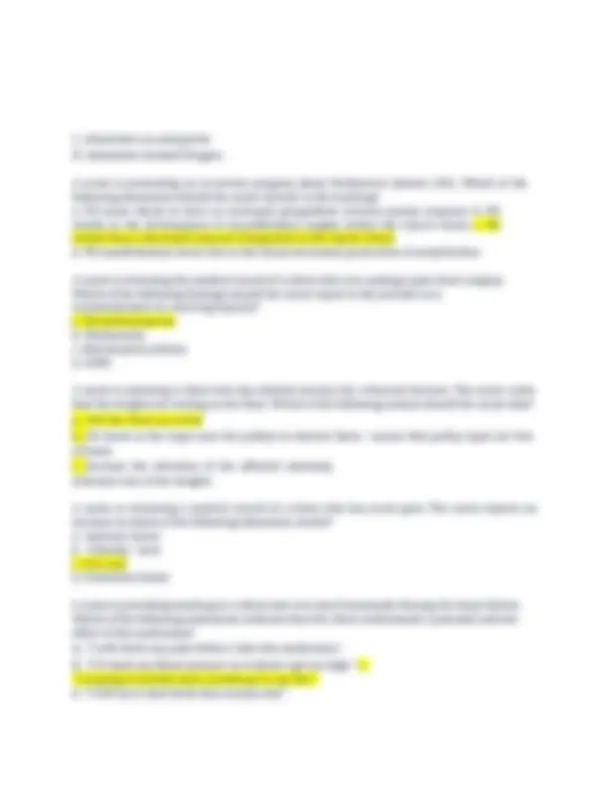


Study with the several resources on Docsity

Earn points by helping other students or get them with a premium plan


Prepare for your exams
Study with the several resources on Docsity

Earn points to download
Earn points by helping other students or get them with a premium plan
Community
Ask the community for help and clear up your study doubts
Discover the best universities in your country according to Docsity users
Free resources
Download our free guides on studying techniques, anxiety management strategies, and thesis advice from Docsity tutors
ATI MEDSURG PROCTORED EXAM Study Guide Questions and Answers A nurse is assessing a client who is 12hr postoperative following a colon resection. Which of the following findings should the nurse report to the surgeon? a. Heart rate 90/min b. Absent bowel sounds c. Hgb 8.2 g/dl d. Gastric pH of 3.0 (normal 0-4) A nurse is caring for a client who has diabetes insipidus. Which of the following medications should the nurse plan to administer? a. Desmopressin b. Regular insulin c. Furosemide d. Lithium carbonate A nurse is admitting a client who has arthritic pain and reports taking ibuprofen several times daily for 3 years. Which of the following test should the nurse monitor? a. Fasting blood glucose b. Stool for occult blood c. Urine for white blood cells d. Serum calcium -
Typology: Exams
1 / 18

This page cannot be seen from the preview
Don't miss anything!











A nurse is assessing a client who is 12hr postoperative following a colon resection. Which of the following findings should the nurse report to the surgeon? a. Heart rate 90/min b. Absent bowel sounds c. Hgb 8.2 g/dl d. Gastric pH of 3.0 (normal 0-4) A nurse is caring for a client who has diabetes insipidus. Which of the following medications should the nurse plan to administer? a. Desmopressin b. Regular insulin c. Furosemide d. Lithium carbonate A nurse is admitting a client who has arthritic pain and reports taking ibuprofen several times daily for 3 years. Which of the following test should the nurse monitor? a. Fasting blood glucose b. Stool for occult blood c. Urine for white blood cells d. Serum calcium - A nurse in the emergency department is assessing a client. Which of the following actions should the nurse take first (Click on the "Exhibit" button for additional information about the client. There are three tabs that contain separate categories of data.) a. Obtain a sputum sample for culture b. Prepare the client for a chest x-ray c. Initiate airborne precautions d. Administer ondansertron. A nurse is contacting the provider for a client who has cancer and is experiencing breakthrough pain. Which of the following prescriptions should the nurse anticipate? a. Transmucosal fentanyl b. Intramuscular meperidine c. Oral acetaminophen d. Intravenous dexamethasone A nurse is admitting a client who reports chest pain and has been placed on a telemetry monitor. Which of the following should the nurse analyze to determine whether the client is experiencing a myocardial infarction? a. PR interval b. QRS duration
c. T wave d. ST segment A nurse is teaching a client who has ovarian cancer about skin care following radiation treatment. Which of the following instructions should the nurse include? a. Pat the skin on the radiation site to dry it b. Apply OTC moisturizer to the radiation site c. Cover the radiation site loosely with a gauze wrap before dressing d. Use a soft washcloth to clean the area around the radiation site A nurse is caring for a client who is receiving a blood transfusion. The nurse observes that the client has bounding peripheral pulses, hypertension, and distended jugular veins. The nurse should anticipate administering which of the following prescribed medications? a. Diphenhydramine b. Acetaminophen c. Pantoprazole d. Furosemide A nurse is assessing a client who is receiving magnesium sulfate IV for the treatment of hypomagnesemia. Which of the following findings indicates effectiveness of the medication? a. Lungs clear b. Apical pulse 82/min c. Hyperactive bowel sounds d. Blood pressure 90/50 mm Hg A nurse is reviewing a client's ABG results pH 7.42, PaC02 30 mm Hg, and HCO3 21 mEq/L. The nurse should recognize these findings as indication of which of the following conditions? a. Metabolic acidosis b. Metabolic alkalosis c. Compensated respiratory alkalosis d. Uncompensated respiratory acidosis A nurse is caring for a client who has a deep partial thickness burns over 15% of her body which of the following labs should the nurse expect during the first 24 hours a. Decreased BUN b. Hypoglycemia c. Hypoalbuminemia d. Decreased Hematocrit
b. BUN 22 mg/ dl c. WBC count of 16,000/ mm 3 d. Blood glucose of 120 mg/dl A nurse is providing dietary teaching to a client who has chronic kidney disease and a decreased glomerular filtration rate. Which of the following statements by the client indicates an understanding of the teaching? a. I will spread my protein allowances over the entire day b. I should increase my intake of canned salmon to three times per week c. I will season my food with lemon pepper rather than salt d. I should limit my intake of hard cheese to 3 ounces each day A nurse is caring for a client who has a PICC.. The client is receiving an antibiotic via intermittent IV bolus. Which of the following actions should the nurse take? a. Administer 20 ml of 0.9 sodium chloride after each dose of medication b. Flush the catheter using a 5 ml syringe c. Verify the placement with an x ray prior to the initial dose d. Change the transparent membranes dressing daily A nurse is teaching a client using a metered dose rescue inhaler. Which of the following statements should the nurse include in the teaching? a. Do not shake your inhaler before use b. Exhale fully before bringing the inhaler to your lips c. Depress the canister after you inhale d. Use peroxide to clean the mouthpiece if your inhaler A nurse is assessing the pain status of a group of clients. Which of the following findings indicate a client is experiencing referred pain? a. A client who has angina reports substernal chest pain b. A client who has pancreatitis reports pain in the left shoulder c. A client who is postoperative reports incisional pain d. A client who has peritonitis reports generalized abdominal pain A nurse is caring for a client who has just returned from surgery with an external fixator to the left tibia. Which of the following assessments findings requires immediate intervention by the nurse? a. The client reports a pain level of 7 on a scale from 0 -10 at the operative site. b. The clients capillary refill in the left toe is 6 seconds c. The client has an oral temperature of 38.3 (100.9 F) d. The client has 100 ml of blood in the closed suction drained.
A nurse is assessing a client who has acute pancreatitis and has been receiving TPN for the past 72 hours. Which of the following findings requires the nurse to intervene? a. Right upper quadrant pain b. Capillary blood glucose level of 164 mg/dl c. WBC count 13,000/mm d. Crackle in bilateral lower lobes A nurse is caring for a client who has hypotension, cool and clammy skin, tachycardia, and tachypnea. In which of the following positions should the nurse place the client? a. Reverse Trendelenburg b. Side Lying c. High Fowlers d. Feet elevated A nurse is caring for a client who has tuberculosis and is taking rifampin. The client reports that her saliva has turned red-orange in color. Which of the following responses should the nurse make? a.) "This finding may indicate possible medication toxicity" b.) "Your provider will prescribe a different medication regimen" c.) "This is an expected adverse effect of this medication" d.) "You will need to increase your fluid intake to resolve this problem" A nurse is preparing to administer a unit of packed RBCs for a client who is receiving a continuous IV infusion of 5% dextrose in water. Which of the following actions should the nurse take? a.) Administer the unit through secondary IV tubing b.) Verify the blood product with an assistive personnel c.) Begin an IV infusion of 0.9% sodium chloride d.) Insert another 22-gauge IV catheter A nurse is planning care for a client who is 12 hr post-operative following a kidney transplant. Which of the following actions should the nurse include in the plan of care? a.) Check the client's blood pressure every 8 hr b.) Administer opioids PO c.) Assess urine output hourly d.) Monitor for hypokalemia as a manifestation of acute rejection A nurse in an emergency department is assessing a client who has cirrhosis of the liver. Which of the following is a priority finding? a.) Yellow sclera b.) Mental confusion c.) Palmar erythema
c. Auscultate the client's lung sound d. Determine the need for further glucose monitoring A nurse is assessing a client who has nephrotic syndrome. Which of the findings should the nurse expect? a. Proteinuria b. Flank pain c. Hyperalbuminemia d. Hypotension A nurse is assessing a client who has right-sided heart failure. Which of the following assessment findings should the nurse expect to find? a. Oliguria b. S3/S4 galloping heart sounds c. Poor skin turgor d. Pitting edema A nurse is caring for a client who has newly inserted chest tube. The nurse should clarify which of the following prescriptions with the provider? a. Notify the provider when tidaling ceases. b. Assisting the client out of bed three times daily. c. Vigorously strip the chest tube twice daily. d. Administer morphine 2 mg IV bolus every 3 hr PRN for pain. A nurse is teaching a client who is taking an ACE inhibitor for heart failure. Which of the following instructions should the nurse include for home management of heart failure? a. Obtain daily weight. b. Use of salt substitute. c. Monitor I and O. d. Limit daily activity. A nurse is providing discharge teaching to a client who has a permanent pacemaker. Which of the following statements by the client indicates an understanding of the teaching? a. I need to maintain pressure over the pacemaker site with an elastic bandage. b. I need to check my pulse rate every day for a full minute. c. The pacemaker will deliver shock if I develop a dysrhythmia d. When a microwave oven is in use, I need to stay out of the room. A nurse in a clinic is providing preventive teaching to an older adult client during well visit. The nurse should instruct the client that which of the following immunization are recommended for healthy adults after age 60? select all that apply:
a. Herpes Zoster b. Influenza c. HPV d. Meningococcal e. Pneumococcal Polysaccharide A nurse is assessing a client who is 4hr postoperative following arterial revascularization of the left femoral artery. Which of the following findings should the nurse report immediately? a. Bruising around the incision site b. Pallor in the affected extremity c. Urine output 150mL over 4hr d. Temperature of 37.9 (100.2) A nurse is caring for an older adult client who has not been eating. Which of the following findings indicates dehydration? a. Crackles auscultated bilaterally b. Capillary refill of 2 seconds c. Dimiminished peripheral pulses d. Engorged neck veins
A nurse is assessing a client 15 min after the start of a transfusion of 1 unit of packed RBC's. Which of the following findings is an indication of a hemolytic transfusion reaction? a. Hypotension b. Bradypnea c. Bradycardia d. Hypothermia A nurse in an emergency department is caring for a client who has sinus bradycardia. Which of the following actions should the nurse take first? a. Prepare the client for temporary pacing. b. Initiate IV fluid therapy for the client c. Measure the client's blood pressure d. Administer atropine to the client A nurse is caring for a client who has a prescription to discontinue a PICC.. Which of the following actions should the nurse take? a. Apply slight pressure when resistance is met b. Measure the catheter after removal c. Remove the catheter with one continuous motion d. Place a dry sterile dressing to the site after removal A nurse is caring for a client who has a flail chest. Which of the following actions should the nurse take? a. Provide humidified oxygen b. Implement fluid restriction c. Administer antibiotic medication d. Administer acetaminophen orally A nurse is teaching a group of newly licensed nurses about acute respiratory failure. Which of the following manifestations should the nurse include in the teaching? a. Hypoxemia b. Hyperventilation c. Hypocarbia d. Hypervolemia A nurse is caring for a client who is experiencing a seizure. Which of the following actions should the nurse take first? a. Obtain the client's vital signs b. Clear items from the client's surrounding area c. Loosen the client's restrictive clothing d. Lower the client to the floor
A nurse is teaching a client who is receiving total parenteral nutrition at home through a central venous access device about transparent dressing changes. Which of the following instructions should the nurse include in the teaching? a. Change the dressing every 48 hr b. Replace the extension tubing with each dressing change c. Use clean technique when changing the dressing d. Wear a mask during dressing change A nurse is caring for a client in the emergency department who experienced a full- thickness burn injury to the lower torso 1 hr ago. Which of the following findings should the nurse expect? a. Decreased respiratory rate b. Hypotension c. Bradycardia d. Urinary diuresis A nurse is providing instructions about foot care for a client who has a peripheral arterial disease. The nurse should identify which of the following statements by the client indicates an understanding of the teaching? a. "I apply a lubricating lotion to the cracked areas on the soles of my feet every morning" b. "I use my heating pad on a low setting to keep my feet warm." c. "I soak my feet in hot water before trimming my toenails" d. "I rest in my recliner with my feet elevated for about an hour every afternoon" A nurse is teaching a client who has a new prescription for alendronate to treat osteoporosis. Which of the following instructions should the nurse include in the teaching? Page 447 MS ati PDF 10. a. Swallow the medication with 120mL (4 oz) of water b. Take the medication with a vitamin E supplement c. Sit upright for 30 min after taking the medication d. Take the medication with lunch A nurse is admitting a client to the emergency department after a gunshot wound to the abdomen. Which of the following actions should the nurse take to help prevent the onset of acute kidney failure? a. Initiate beta blocker therapy b. Insert a urinary catheter c. Prepare the client for intravenous pyelogram d. Administer IV fluids to the client
a. I will draw up regular insulin into the syringe first b. I will insert the needle at a 15 degree angle c.I will store prefilled syringes in the refrigerator with the needle pointing downward d.I will shake the NPH vial vigorously before drawing up the insulin A nurse is caring for a client who is receiving Total parenteral Nutrition (TPN). which of the following nursing actions are appropriate? (Select all the apply) a. Obtain the client's weight daily b. Increase the rate of infusion if Administration is delayed - c.Monitor serum blood glucose during infusion d.In to use 0.9% sodium chloride if the solution is not available e. Verify the solution with another RN prior to infusion
. A nurse is caring for a client in DKA.. Which of the following is the priority intervention by the nurse? a. Check potassium levels b. Administer 0.9% sodium chloride c. Begin bicarbonate continuous IV infusion d. Initiate continuous IV insulin infusion A nurse is reviewing the laboratory results of a female client who asked about acupuncture treatment for chemotherapy-induced nausea and vomiting. Which of the following laboratory results is an indication to receiving acupuncture? a. Absolute neutrophil count 500/mm b. C-reactive protein 0.7 mg/dl c. platelets 160,000/mm3 d. Hemoglobin 12 /dl A nurse is caring for a client following a total knee arthroplasty. The client reports a pain level of 6 on a Pain Scale of 0 to 10. which of the following should the nurse take? a. Gently massage the area around the clients incision b. Place pillows under the client's knee c. Apply an ice pack to the client's knee d. Perform range of motion exercises to the client's knee A nurse is Assessing a client who has heart failure and is receiving a loop diuretic. Which of the following findings indicates hypokalemia? a. Hypertension b. positive chvostek's sign c. Muscle weakness d.Oliguria
A nurse at a long-term care facility is assessing an older adult client. Which of the following findings should the nurse identify as an indication that the client has recall memory impairment? a. Inability to state what he had for dinner last night b. Inability to Name the members of his family c. Inability to count backwards from 10 d. Inability to state his current age A nurse on an intensive care unit is planning care for a client who has increased intracranial pressure following a head injury. Which of the following IV medications should the nurse plan to administer? a. Chlorpromazine b. Dobutamine c. Mannitol d. Propanol
. A nurse on a medical unit is planning care for a group of clients. Which of the following clients should the nurse attend to First? a. A client who has thrombocytopenia and reports and nosebleed b. A client who has chronic obstruction pulmonary disease and oxygen saturation of 89% c. A client who has multiple sclerosis and Ataxia and vertigo d. A client who has left-sided paralysis and slurred speech from a prior stroke A home care nurse is planning to use non pharmacological pain relief measures for an older client who has severe chronic back pain. Which of the following guidelines should the nurse use? a. Use imagery with clients who have difficulty with focus and concentration b. Pain relief from the use of heat and cold continues for several hours after removal of the stimulus c. Discontinue opioids before trying non pharmacological methods of pain relief d. Distraction changes the client's perception of pain but does not affect the cause A nurse is caring for a client who has pneumothorax and a chest tube with closed water seal drainage system. Which of the following actions should the nurse take? a. Strip or clear the chest tube every 8 hours b. Refill the water chamber if the fluid is low c. Empty the system at least every 8 hr d. Change the chest to site dressing every 24 hour –
b. Meperidine c. Naproxen d. Oxycodone A nurse is caring for a client who has Haemophilus Influenzae type B. which of the following types of isolation should the nurse implement? a. Droplet b. Contact c. Airborne d. Protective A nurse is providing discharge teaching to a client who has pulmonary tuberculosis. Which of the following findings should the nurse include as an indication the client is no longer infectious? a. Mantoux skin test reveals and induration of less than 1mm b. Client no longer coughing up blood tinged sputum c. Positive quantiferon TB gold test d. Negative sputum culture for acid fast bacillus
. A nurse working in the emergency department is caring for a client who has a burn injury. After securing the client's Airway which of the following interventions should the nurse take first? a. Cleanse the client wound b. Administer Analgesic medication c. Increase the room temperature d. Start an IV with a large bore needle A nurse is caring for a client who has a central venous access device and notes the tubing has become disconnected. The client develops dyspnea and tachycardia. Which of the following actions should the nurse take first? a. Obtain ABG values b. Perform an ECG c. turn the client to his left side d. Clamp the catheter .A nurse is providing discharge teaching to a client who has impaired immune system due to chemotherapy. Which of the following information should the nurse include in the teaching? a. Wash your perineal area 2 times each day with antimicrobial soap b. Change the water in your drinking glass every 4 hours c. Wash your toothbrush in the dishwasher once each month d. Change your pet litter box daily
A nurse is caring for a client who has advanced liver disease. Which of the following laboratory results should the nurse monitor when assessing the client? a. Serum Ammonia b. Glucose level c. Phosphate level d. Serum troponin A nurse is caring for a client who has admitted with nausea, vomiting, and a possible bowel obstruction. An NG tube is placed and set to low intermittent suction. Which of the following findings should the nurse report to the provider? a. The client reports being extremely thirsty with a sore throat b. The amount of drainage is gradually decreasing c. The client's abdomen becomes distended and firm d. The drainage is bright green in color with brown fecal material A nurse is caring for a client who takes Lisinopril for HTN. Which of the following client statements indicates an adverse effect of the medication? a. I have a heightened sense of taste b. I have a nagging, dry cough c. I have to urinate frequently d. I seem to be bruising more easily A nurse is caring for a client who has an endotracheal tube. Which of the following actions should the nurse take to verify tube placement? a. Deflate the cuff to check the tube placement b. Place the client's head and neck in a flexed position c. Observe for symmetry of chest expansion d. Document the tube length where it passes the chin A nurse is providing discharge teaching to a client who has chronic urinary tract infections. The client has a prescription for ciprofloxacin 250 mg PO twice daily. Which of the following instructions should the nurse include in the teaching? a. Take a laxative to prevent constipations b. Take an antacid 30 min before taking the medication c. Monitor heart rate once daily d. Drink 2 to 3 L of fluid daily
. A nurse is caring for a client who presents to the emergency department after experiencing a heat stroke. Which of the following actions should the nurse take? a. Apply a cooling blanket. b. Assess axillary temperature every 15 min.